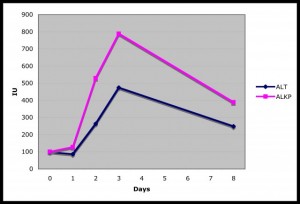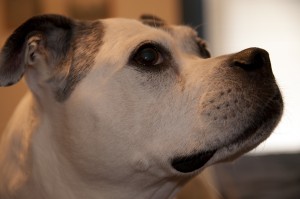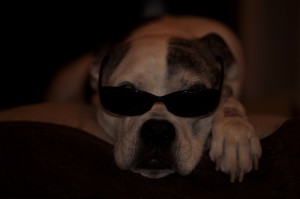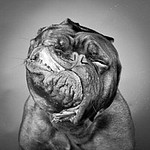A couple of days ago, Liliana sent me a link to one of her favorite blogs: Love & a six-foot leash. I had visited this site before and enjoyed looking at the photos of Aleksandra’s dogs, and the dogs that she fosters. Aleksandra and her family help a few unlucky pit bull-type dogs by taking the unloved and often mistreated dogs into their home, caring for and loving them, and then ultimately, finding them their perfect family and forever home. Aleksandra’s mission, however, is much larger than rescuing and placing some dogs in new homes with loving families.
Pit bulls and pit bull-type dogs suffer the misfortune of a maligned reputation. Evening news reports of vicious attacks on innocent people ring in the ears of moms, dads and children. I will never forget the time when Lili and I were walking our two American bulldogs on the small, shop-lined streets of Cape May, NJ, and a young child, about six or seven years old, pointed at our dogs and cried out, “Devil dogs! Those are devil dogs!!” The parents were obviously embarrassed as they shushed the boy and quickly disappeared into the crowd of vacationers, but it was too late; the damage had been done. From that day forward, I always wondered what people were thinking about my muscular, blocky headed dogs as they watched them at the end of their six-foot leashes. Aleksandra’s greatest mission is to affect change in the way people see and think of pit bulls and pit bull-type dogs. As with every other person who has ever had the privilege of knowing these wonderful, loving companions, she understands that the harsh, discriminatory views of these dogs is a product purely of misinformation and ignorance.
In a post titled, “One of these dogs is (or is not) like the other: Defining a “pit bull” dog”, Aleksandra presents her readers with a pop quiz. Above a photograph of her two blocky headed dogs, Aleksandra asks one question: Which of her two dogs is a “pit bull” dog? The multiple choice answers are:
A) Both
B) Neither
C) Chick only
D) Doodlebug only
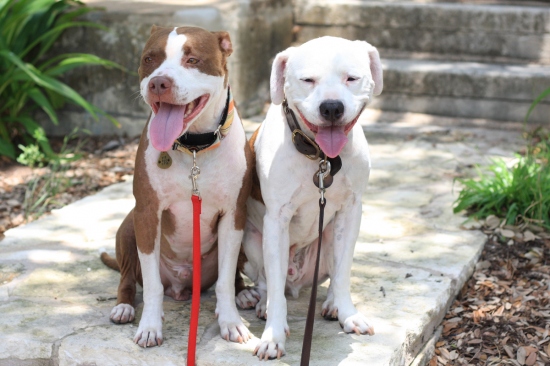
Photo: Juliana Willems. Site: Love & a six-foot leash.
Yes, her dog’s names are Chick and Doodlebug. She refers to the pair of them as, Chickerdoodle
Aleksandra recently had a DNA test done on Doodlebug, and I guess, previously had one done on Chick. The quiz poses an interesting question: What is a pit bull? We must be able to define exactly what a pit bull is if we want to have any success on this quiz!
If a pit bull is any dog with a muscular physique, then the answer is A) Both. If a pit bull is any dog with a blocky head, then the answer is A) Both. If a pit bull is any dog with large jaw muscles, then the answer is A) Both. If a pit bull is any dog with a stocky body and short fur, then the answer is A) Both. If a pit bull is any athletically built dog with almond shaped eyes, then the answer is A) Both.
At this point, it looks like I’m going to Ace this quiz. For all the criteria that describe what a pit bull is, the answer is always A) Both. Is it really that simple though? Is there something in the breed name that can help us decipher what a pit bull is? To follow up on that question, is “pit bull” a breed of dog? In my mind, No. Pit bull is not a breed of dog. Pit bull was a descriptive title given to dogs that were used for a specific type of entertainment – dog fighting. The fights were often held in rings, rooms, yards and actual pits. Dog fighting grew in popularity in Europe during the seventeenth century, but as we all know, the roots of these blood sports go back much further. Tournaments ‘pitting’ beast against beast, beast against man, and man against man were popular in ancient Egypt, Greece, Rome, and no doubt, have a longer history than we are aware of.
Let’s look at the etymology of the name, “pit bull terrier”. When most people think of ‘working animals’, images of draft horses, mules, oxen, and even elephants are probably what go through most people’s minds; however, before dogs became the most popular, beloved companion animals that they are today, they also performed work for their human masters (some still do). The work ranged from guard and attack duty, to herding grazing animals and mushing sleds through ice and snow.
In medieval England the sport of baiting was very popular and drew large crowds who were enthralled by the excitement, blood and gore of the events. Baiting consisted of the unleashing of one or more trained dogs to attack and bring to submission another animal, most commonly a bull; hence the name, bulldog. Baiting was more than just a sport, however. The baiting of bulls was a practice used to render the meat of the bull more tender and nutritious, and in many towns, butchers were required by law to bait bulls before slaughter or face a penalty.
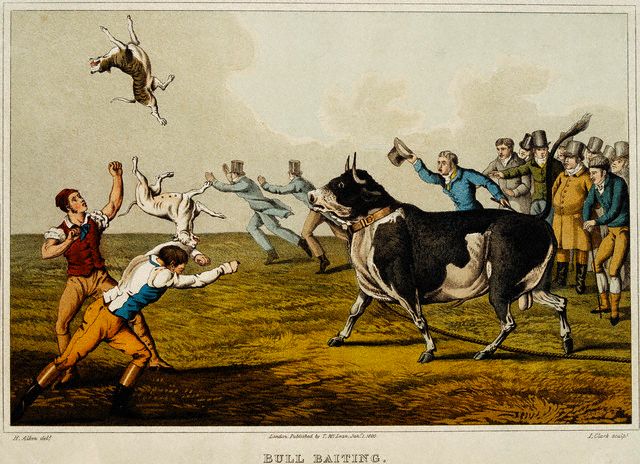
The story goes that after a few particularly bloody and gory baiting events – more than one at which a dog was slowly dismembered by his master while the dog held steadfastly to the bull to show off his dog’s unrelenting tenacity – people began to condemn the sport of baiting. After some time, baiting was outlawed. The illegalization of baiting lead to the rise in popularity of dog fighting. Some historians believe that in order to create better, and perhaps, smaller fighting dogs, some type of game terrier dogs were bred with bulldogs. Whether this is true or not, no one can say with one hundred percent certainty, but it does explain the ‘terrier’ in pit bull terrier.
Now that we’ve dissected the name, “pit bull terrier”, it appears that the moniker describes a dog with a certain job. This is similar to when we refer to a person by his job or professional title, such as, doctor or janitor. It’s not a DNA thing; it’s a job title thing. Concerning pit bulls and DNA, that brings up another Question – What exactly is a pit bull terrier?
It seems that there is no definitive answer to what a pit bull is. The genetic makeup of pit bulls is a mystery. There are some people who claim to know the genetic pieces of the true, original pit bull, but of all those people who claim to know, no two agree. Are today’s true American pit bull terriers direct and untainted descendants of the original bulldogs of old England? Or are American pit bull terriers the product of a cross between the original bulldogs of England and some unknown terrier dogs?
In my opinion, it is very unlikely that the original bulldogs of the early nineteenth century and earlier England survive in pure form as today’s American pit bull terrier. The likely-hood that a working dog breed whose job he was displaced from almost two hundred years ago, remains genetically unchanged, is extremely slim. As previously stated, once bull baiting was outlawed by parliament in 1835, the popularity of dog fighting exploded. Some records indicate that game terrier dogs were introduced to the bulldog gene pool for the purpose of increasing tenacity and endurance. Breeders guarded their pit fighting dog’s pedigrees in secrecy for competitive reasons. This secrecy of breeders suggests that crossbreeding did occur, and was probably quite common. When one looks at artist’s renditions and photographs of fighting dogs during the sport’s heyday, it becomes apparent that there is no clear and consistent phenotype. I think that the evidence, along with common sense, suggests that the original bulldog and today’s American pit bull terrier are two distinct breeds. To go a step further, I do not believe that pit bulls exist as a genotype.
So then, back to Aleksandra’s Chick and Doodlebug. Are they pit bulls? Is either one a pit bull? Since neither Chick nor Doodlebug are involved in dog fighting, I do not believe that either of them are pit bulls. Not in the strictest sense anyway. That’s not to say that I don’t refer to my sweet, lovable and super social, Tommy, as a pit bull.
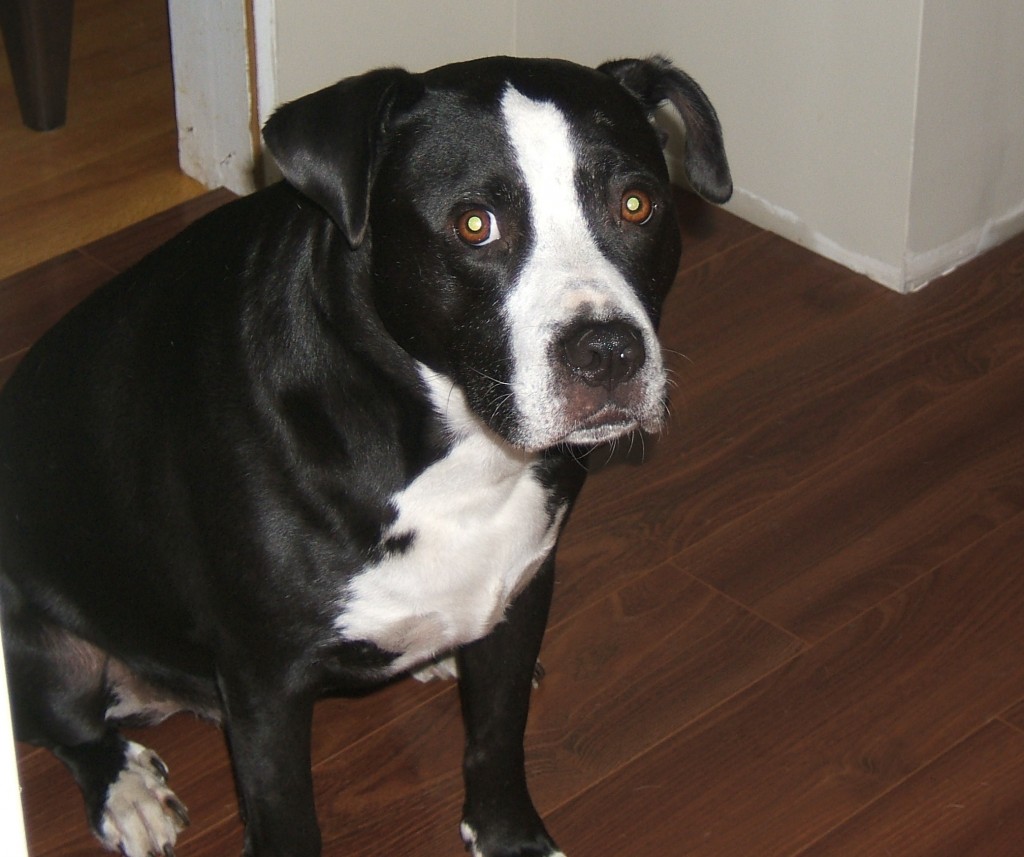
Society has come to associate certain physical characteristics in dogs as identity markers of pit bulls. I guess this is where the term, pit bull-type dogs comes from. Chick and Doodlebug look like what most people think of as pit bulls, but they are not pit fighters, and their DNA proves conclusively that they are, as units (that sounds funny), completely different breeds.
To reiterate an earlier point, I do not feel that a specific DNA sequence determines whether or not a dog is a pit bull. The sole determiner for pit bull identification is the job that a dog performs. If a dog is toted around in a Gucci purse and wears designer doggy attire, then it isn’t a pit bull. If a dog spends his days watching television on the couch with his master and enjoys the occasional dropped potato chip, then that dog is not a pit bull. If the dog is trained to be animal-aggressive and participates in organized dog fights once a month, then that dog is a pit bull.
To answer three of Aleksandra’s questions:
• Is Chick less of a pit bull after his DNA test, which revealed no SBT or AST? No, Chick is no more or less of a pit bull now than before. He was not a pit bull before the DNA test, and he isn’t one now.
• And is Doodlebug more of one? Doodlebug isn’t a pit bull either. The fact that he shares some DNA with breeds that have been identified as pit bull-type dogs really has no significance.
• And can two mixed-breed dogs that share zero common breeds both be “pit bull” dogs? The answer to this one is yes. Again, pit bulls are defined by the job that they perform.
And the answer to the pop quiz: is B) Neither.
I am glad that Aleksandra created her pop quiz, because it motivated me to write this post. I enjoyed learning the results of Chickerdoodle’s DNA tests, and I’ll always happily give in to any excuse to look at photos of dogs. Unfortunately, it also makes clear a growing problem and a threat to anyone who loves pit bulls and pit bull-type dogs: breed specific legislation is a flawed concept that can take your beloved pet away from you.
People in government wield the power to take your pet away from you by force, as occurred in Denver, CO in 1989, Winnipeg, Canada in 1990, and other places around the world. Pit bulls and pit bull-type dogs are classified as dangerous breeds, but they are so loosely defined by the various governing bodies that almost any dog can be labeled a pit bull or pit bull-type dog, and consequently taken from your possession. It’s scary to think that under different circumstances, both Chick and Doodlebug could be removed from their home by force because they look a certain way. They could be classified as a dangerous breed even though they share no common DNA, as evidenced by their Wisdom Panel Insights DNA test. How could two dogs with no common DNA be considered the same dangerous breed? I guess we know which answer from Aleksandra’s pop quiz proponents of breed specific legislation would choose. What a shame – fear from ignorance. I think we as a people have seen this phenomenon before.
 Molly, the second dog in the Mason Bone Cancer Study, just finished her stay at UPenn with Dr. Mason. Her owner, Jenn, says that Molly was fairly comfortable during her stay at the hospital. She received the L. Monocytogenes vaccine on Tuesday, July 24. Molly’s temperature increased two degrees above normal as a result of the bacteria floating around in her system. Jenn also said that Molly’s white blood cell count doubled, but her liver values remained normal.
Molly, the second dog in the Mason Bone Cancer Study, just finished her stay at UPenn with Dr. Mason. Her owner, Jenn, says that Molly was fairly comfortable during her stay at the hospital. She received the L. Monocytogenes vaccine on Tuesday, July 24. Molly’s temperature increased two degrees above normal as a result of the bacteria floating around in her system. Jenn also said that Molly’s white blood cell count doubled, but her liver values remained normal.